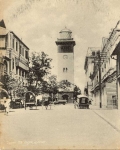Old Colombo Lighthouse
Archaeology »
Archaeological Monuments » Old Colombo Lighthouse
Old Colombo Lighthouse -
Old Colombo Lighthouse is located in Colombo.
Old Colombo Lighthouse monument was established on 1860.
Primary threats to Old Colombo Lighthouse :
It is not operational any more, but functions as a clock tower and is designated as a monument.
Historical facts of Old Colombo Lighthouse :
- The Old Colombo Lighthouse monument, established in 1860, is an iconic landmark located in the city of Colombo, Sri Lanka. This historical structure holds significant importance, not only as a navigational aid but also as a symbol of the city's rich maritime history. Standing tall at the entrance of the Colombo harbor, the lighthouse has witnessed the transformation of Colombo from a colonial port to a bustling modern metropolis.
- The construction of the Old Colombo Lighthouse was commissioned during the British colonial era, with the primary objective of ensuring the safe navigation of ships entering the harbor. The lighthouse was designed by Sir James Nicholas Douglass, a renowned Scottish engineer who specialized in constructing lighthouses. Douglass's expertise and architectural vision led to the creation of a magnificent structure that would serve as a beacon of light for sailors navigating the treacherous waters surrounding Colombo.
- The lighthouse originally featured a clockwork mechanism that powered the rotation of a massive lens, emitting a powerful beam of light that could be seen from a considerable distance. The light emitted from the lighthouse provided essential guidance to ships, allowing them to avoid dangerous rocks and reefs that posed a threat to their safe passage. Over the years, advancements in technology led to the modernization of the lighthouse, with the introduction of electric lighting systems and more sophisticated navigational aids.
- Apart from its practical significance, the Old Colombo Lighthouse holds a deep historical significance for the city of Colombo. It stands as a reminder of the city's colonial past and its strategic importance as a vital port in the Indian Ocean. During the height of British rule, Colombo served as a crucial trading hub, connecting various parts of the British Empire and facilitating the movement of goods and people across the globe. The lighthouse played a pivotal role in ensuring the smooth operation of maritime activities and bolstered Colombo's reputation as a maritime powerhouse.
- Over the years, the lighthouse has withstood the test of time and witnessed significant historical events. It stood witness to the arrival and departure of countless ships, including grand ocean liners, cargo vessels, and naval fleets. The monument also witnessed the changes that accompanied Sri Lanka's journey to independence in 1948, marking a new chapter in the country's history.
- While the Old Colombo Lighthouse served its purpose diligently for over a century, the construction of a taller and more modern lighthouse in the early 1970s led to its decommissioning. However, recognizing its historical value, the Sri Lanka Ports Authority decided to preserve the monument as a cultural landmark and a symbol of Colombo's heritage.
- Today, the Old Colombo Lighthouse stands as a popular tourist attraction, drawing visitors from around the world. Its elegant structure and scenic location make it a favorite spot for photography enthusiasts, capturing the essence of Colombo's maritime past. The monument serves as a testament to the city's resilience and adaptability, embracing its history while propelling itself into the future as a vibrant and cosmopolitan capital.
- In conclusion, the Old Colombo Lighthouse, established in 1860, is a historical monument that symbolizes the maritime heritage of the city of Colombo. Through its enduring presence, the lighthouse bears witness to the city's colonial past, its pivotal role in maritime trade, and its transformation into a modern metropolis. As a cultural landmark and a popular tourist attraction, the Old Colombo Lighthouse stands as a testament to Colombo's rich history and serves as a beacon of pride for the people of Sri Lanka.

